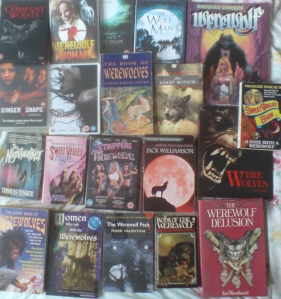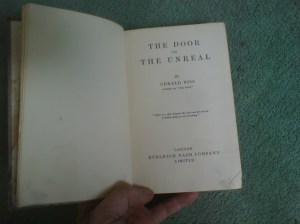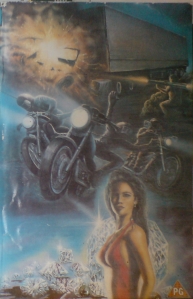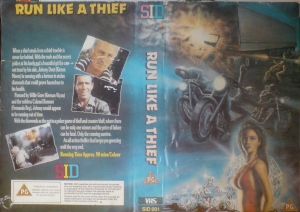It’s coming up to the second anniversary of the death of James Herbert. With incredible self-centred-ness, I find the date of his death easier to remember than the deaths of some of my loved ones: because Herbert just happened to pass away on my birthday.
I met him once at a book signing, and until he died I had hoped one day to meet him again. That day I felt it somehow weird to bring every one of his books to be signed, so had whittled their number down to just five favourites; but on hearing this he beamed and cried, “Why? Bring ’em all! Go on, bring ’em all!” I don’t think a writer has ever made me feel more welcome, or conveyed such gratitude for the compliment I presumably paid him by enjoying his books. I found the nasty, twisted author of these kinky, filthy horror adventures, the man who could fictionally castrate a young boy and throw him down a well to bleed to death, was, in person, loud, gracious, and warm. I think (and if you look, the clues are in his books) that he most likely had a big heart.

FLUKE
I love Fluke. It was my entry into the works of James Herbert, and I’m not sure I would feel the same about the man’s writing if I had started elsewhere. I was probably something like 11 or 12 when, in the school library, I glanced at the Adult fiction section, instead of my home ground, Children, and saw a book cover that intrigued me with its image and the line: “The story of a man who thinks he’s a dog…or a dog who thinks he’s a man.” I had to double-check that the book wasn’t a childrens’ book after all, but it didn’t seem to be; nonetheless, this idea appealed to me as much as Bambi or Treasure Island or The Hounds Of The Morrigan, so I borrowed it and read it, making Fluke the first adult book I ever read. Whoever knew grown-ups could read something so much fun?!
The authorial voice, compared to his previous books, is witty, trickster-ish, fanciful. Fluke, the central character, is likeable, self-deprecating, and wise, and his friend Rumbo is one of Herbert’s best, liveliest creations. The sequence with Miss Birdle and her vicious cat is unforgettable. But enough with the adjectives; what makes the book work? And how on earth does this playful fantasy fit in with the more gutsy sucker-punch horror of one of England’s nastiest, dirtiest writers of the 70s?
All right, that’s a disingenuous question; after all, why should it? A better one might be, what does comparison of this novel with Herbert’s more typical books tell us about his writing? What don’t we get, noticeably, in Fluke, that we normally get from Herbert? There’s no WWII reference, no house with a haunted past, there is not a slam-bang action climax (though it has one of Herbert’s greatest final pages, matched only by Sepulchre and The Jonah), there is no sex scene, the novel is devoid of set pieces involving minor characters, even the extended spatially-vivid chase sequence is absent. Mutilation and violent death, barely a whisper. The story doesn’t even have a villain! Iconic London landmarks are absent, as are threats to society as a whole.
What we do have, that ties it to other books by James Herbert, is a character living two lives: more specifically, living one life while haunted by the awareness of another. The image of an isolated, free-roaming dog cut out of life by another man, a usurper of his position is echoed by the out-of-body protagonist in Nobody True, watching from the world of astral projection as another man, a sort of double or non-identical twin, takes his place, living in his home with his family. The moral trajectory of the tale is reversed: in Fluke, the hated usurper is revealed as a maligned, loving friend, whereas in Nobody True, the character’s best friend is revealed as a traitor. Similarly, in Once… (more fanciful and detailed than Fluke but a weaker and less original story), the friendless protagonist is surprised to learn that he is the half-brother of a man whose attitude to him is ambiguous: not all kind, not all cruel.
In Others, there is a kind of twinning-of-opposites; like Yin and Yang, who contain each other’s essence at their centres, we meet in Others a misshapen narrator with a good heart who is the reincarnation of a heart-throb whose crimes were unbearable to ponder, destructive to the soul. In The Jonah the protagonist Kelso is haunted his whole life by the ghost of his unborn twin, a more literal version of the theme. Arguably, Sepulchre contains an equivalent pairing: Halloran, the hero who is half villainous, is the match for Kline, the villain too weak to triumph. The book’s tagline expresses it: “There are no absolutes…”
There’s another thing, however, besides this theme and the irrepressible cockney humour, that Fluke brings into sharp focus, and that’s Herbert’s sympathy for animals, even a philosophical preference for them. In this book, every animal has a voice and something to say about its point of view – it’s like a more twisted Bambi (book, not film). Dogs speak, cats speak, humans speak but are accorded no particular status above the other animals, and, perhaps most significantly, rats speak. The rat in Fluke, when given the chance to be articulate, expresses a valid and distinctive take on life, albeit a lowly, wild rat’s attitude, and Herbert makes it very clear that Fluke, the dog, kills rats because of instinct – that’s what dogs do – rather than from any innate superiority. As far back as Herbert’s debut, The Rats, came a zoo scene where the animals, disturbed by the rats, freak out and run amuck, and although (Herbert has sympathy for everyone) the zookeeper is an engaging little fellow who feels something like love for the beasts he ‘looks after’, there is still a sense that Herbert the horror writer is siding with the animals – when the zookeeper is mauled by one of his favourites, it feels less like a tragedy than a kind of inevitable natural justice. One of Herbert’s rare short stories (“Extinct”) repeats this idea, being a description of animals reclaiming a city after mankind has destroyed itself – and this same process, as I shall describe, is the overall narrative shape of the Rats trilogy.
The animals in Herbert’s prose – such as the birds in Once… or Joe Creed’s cat in Creed – are conscious entities who are busy living their lives. They aren’t just decoration, and at times – The Magic Cottage, the Rats trilogy, and most of all Fluke – they are what the story is about.
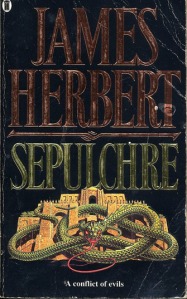
SEPULCHRE
In my favourite Herbert book, Sepulchre, the evil, unusually for Herbert, is defined as an ancient one, related to a prehistorical civilization; and, for whatever reason, Herbert chose the Sumerians. I find this choice interesting, for precisely a reason that Herbert spells out: the main surviving literary text of Sumerian culture is the Epic of Gilgamesh, and it’s a pre-Biblical Flood narrative; Utnapishtim was an earlier version of Noah. Thus, in choosing, for once, an ancient civilization, Herbert eschews Greek, Roman, Egyptian tradition in favour of the source of one of the earliest, longest-lasting Apocalypse narratives in human history.
For what it’s worth, I’m going to look at this for a while, but I’m not a scholar or a literary critic, so bear that in mind.
Apocalypse narratives tell of the End of the World, and what comes after; Apocalypse and Post-Apocalypse are two sides of the same coin. The End can come by a Flood, which makes the world’s end a type of cleansing process, but Apocalypse, of whatever size, could also come by monstrous rats (The Rats, Lair), chemical weapons (The Fog, ’48), nuclear holocaust (Domain), mass insanity (The Dark, The Fog), or the arousal of supernatural forces (The Jonah, Portent, The Ghosts of Sleath, The Spear, Sepulchre, Creed, Shrine). Apocalypse is a recurring idea in the books of James Herbert.
The great apocalypse narrative of the modern age is still HG Wells’s grandly-titled The War Of The Worlds, and this amazing tour-de-force of destruction is a clear influence on Herbert’s epic visions, but Herbert himself once said his favourite Wells book was actually The History Of Mr Polly. For those who don’t know, HG Wells had two broad periods as a fiction writer: the trail-blazing science-fiction genius who destroyed worlds and made nightmares concrete, and the social commentator whose later, ‘literary’ novels observed people with a skilful, sympathetic, sardonic eye. Although Herbert may have enjoyed such novels, which are simply about people and no more, he still never chose to write one; among his books there is no Kipps or Ann Veronica.
The point is this: I’ve chosen Wells precisely because James Herbert put The History Of Mr Polly in his top 10. This opting for Mr Polly over War Of The Worlds makes clear that Herbert returns to the idea of Apocalypse for more personal reasons than merely enjoying it as a literary tool. I think the answer is annoyingly simple: repeatedly, from The Rats (his first novel) through to Ash (his last), Herbert links the Apocalypse, whether circuitously or directly, with World War Two. I don’t mean in a symbolic, ‘sub-text’ way, but in openly spelled-out passages. Even the war of the future, in Domain, is only prepared for by a government which had learnt the harsh lessons of the 1940s. Some of the subterranean escape routes in that novel, we are told, were built during the war against Hitler.
Now – we could, in discussing Apocalypse stories, give a thought to Post-Apocalypse stories. Very few stories are of the former without at least addressing the latter; and in fact, post-apocalyptic fiction is considered so much more valid that writers like PD James and Cormac McCarthy can pen highly-praised post-apocalyptic works without even defining or justifying their apocalypses, as though detailing how the world might end is a vulgar matter, one for hacks and fanfic-writers. This is Apocalypse as Plot Device, which at least Herbert never descended to.
Nonetheless, his novels often feel more post-apocalyptic than properly apocalyptic. He never wrote about WWII without setting the story afterwards, even when this was strictly unnecessary, as in ’48, which could have been called ’44 and set while the war was still raging. It might be that writing about after the huge trauma is exactly what led Herbert to an interest in ghost stories, which are usually about the remains of something bad that happened in a previous time.
I’m trying, though, to write about Sepulchre, and to work out why, for years, it’s been my favourite of Herbert’s books. Placing it – and very awkwardly, too – in a discussion of how Herbert wrote apocalypse and post-apocalypse stories doesn’t help me do that.
What helps more is to place it in a deeply personal list of books or films that I struggled to reach the end of. As a child, if I didn’t like a story, if it scared me, I would stop: throw the book behind the radiator where the monsters couldn’t get me, or leave the cinema. Increasingly, as you get older, you expand those boundaries, and James Herbert plays an interesting part for me there. Firstly, there is the point that Fluke was the first time I ever took a book from the Adult section of the library and read it cover to cover, being neither bored nor traumatised by the experience. It seemed to spell out in detail aspects of life that books for younger readers had avoided entirely, but it was nothing I hadn’t covered in biology lessons, or playground discussions, or comparison of bloodsoaked adolescent nightmares. If anything, Fluke seemed to promise the insight that being a grown-up, in the end, amounts to having permission to talk about the things that throughout youth have been strangely proscribed.
Then a little later – it may have been the third Herbert I read, after Fluke and The Magic Cottage – came The Spear, and two things changed. One was the detailed sex scene, which I was mortified to find confronting me on a crowded morning rush-hour train, at the delicate schoolboy age of about 12. I had to stop reading it in case someone looked over my shoulder, which had never happened with a children’s book but still occasionally still happens with adult books – for instance, the extended racist monologues of the old woman in Carrion Comfort look indescribably embarrassing taken out of context. The other thing in The Spear was the crucified woman with her tongue cut out. This was horrible, deeply horrible, and I wished it hadn’t happened. I wished that somehow the woman had been saved, or that the hero had not had to deal with it. The scene has a kind of visceral, sickening power, and I can still see the images Herbert put in my mind, just as my horrified imagination first envisaged them. But I finished the book, and thought it was the best thing ever. (When I excitedly sketched the plot outlines to my mother, she said it sounded like absolute trash! Of course, I know what she meant now, and I wish I could go back and explain to her that James Herbert wasn’t writing trash, that a young boy’s bubbly recounting of his work conveyed none of the artistry, skill and humanity that made even this grotesque horror show such a wonderful, thrilling novel. Anyway.)
Horror, as a genre, invites you to test your boundaries, which is one reason it perenially attracts young, exploratory audiences. Having crossed various boundaries with Herbert guiding me and survived, I at some point read Sepulchre, and here I hit a snag: the torture scene was too much for me. I read it on a fairly empty tube train and felt something happening as I read; my head got light, my mouth became dry. I was, literally, dizzy with horror. The movement of the train, combined with the torture scene, made my stomach lurch. I was sick; I was going to be sick! At the next station I staggered off the train, closing the book, my vision failing, and collapsed – yes, collapsed! – on the stairs. I sat on a metal step, panting, and I felt very different to how the scene in The Spear had affected me.
In The Spear, I wished that the sadistic violence hadn’t happened, in the context of the story. But with Sepulchre‘s torture scene, I wished I had never read it. A middle-eastern man stopped, concerned, to see if I was all right, and didnt seem reassured when I said it was nothing. “Your face – so pale!” he said, shocked, offering a hand. I have a dim memory of saying I didn’t need a doctor, sitting where I was till the dizziness cleared, then continuing my journey on the next train, the book staying firmly closed.
For a while, I thought I’d gone too far. My delicate sensibilities had been ravaged by a writer I could no longer trust. I thought the book was going to get more and more horrible, and that James Herbert was no longer a writer for me.
But after a time – a few days, I reckon – my feelings changed. I hadn’t suffered any lasting effects, and curiosity was eating away at me. I liked Halloran, the protagonist, I wanted to read more about Felix Kline, the villain (who I still consider one of Herbert’s best characters) – in short, I wanted to finish the story. On going back to it, I found that Sepulchre, for me, has no other scenes quite as horrid as that torture scene, and indeed, the rest of the violence in the book seemed easier to swallow precisely because I had now crossed the pit of burning coals.
Sepulchre was part of my growing up, then. And even with all this, the book would not have resonated so strongly for me without its incredible end. I consider the last chapter of Sepulchre to be a kind of poem of suffering. The whole novel is caught up in ideas of sacrifice, of primitive ritual, of redemption (“Shit, how he hated that word!”), and if the book says anything about life, it seems to be that release comes not in freedom from pain but in the acceptance of pain. As someone who has had to face a lot of bodily pain, due to congenital problems with my lungs, testicles, and jaw – all unrelated issues, but all involving lengthy experiences in hospitals – this message really rings true for me. And in a way, my experience of accepting the horror of the novel itself is an example of this process.
I’d also like to mention that the moral ambiguity encapsulated in the very final word of Sepulchre – is “watching” a threat, or a comfort? – removes this pulpy, at times incoherent monster story from anything like trashiness or obviousness. If anything, the combination of “trash” and spiritual seriousness is exactly what kept me returning to Sepulchre, repeatedly, over the years. If I get, one day, to make a feature film of just one James Herbert novel, I would choose this one. And the end would be exactly what Herbert wrote.
Having said that, I also think Moon, The Jonah, and Domain would make excellent movies, though to make Domain, you’d have to have made some adaptation of The Rats and Lair. I picture the whole rats trilogy as an epic TV series rather than three movies.
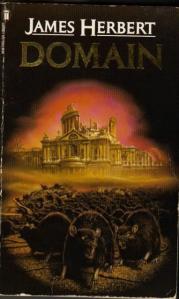
DOMAIN
Herbert was a visual artist who used to say that the reason he wrote his novels by hand was because the physical action reminded him of drawing, and he felt like he was drawing pictures of the scenes, characters, and events in his work. The magic of his writing, the hit that a junkie of his prose like myself keeps coming back for, is a kind of perfect spatial clarity. At times, it’s like a palette of cliched masculinity issues: spatial awareness, fear of emotion, violent urges, and a kind of doing-the-dirty-job-so-women-and-children-don’t-have-to vibe. It’s probably this that ties Herbert to a macho end of readership, the modern white warriors with buttoned lips who read (and take too seriously) Andy McNab, John Norman’s Gor books, Tom Clancy, Frank Miller comics, and nowadays the web-based rantings of so-called men’s-rights-activists.
But I have to point out, Herbert only seems to use these genre tropes in order to criticise them. As early as The Rats, Herbert points out the flaws of an angry anti-Establishment attitude, and present his angry heroes with more detachment than most critics give him credit for. Repeatedly, the “hero” who bottles all his anger up is a problematic figure, and it’s interesting how, in the more war-like stories, the semi-thrillers like The Jonah, Sepulchre, and Domain, the writing actually enters the minds of the female characters instead. There is a macho fear of emotion as a theme in his work, but it’s not in the writing, which describes it critically from outside.
In any case, I wanted to talk about the spatial clarity. There are touches of it in The Rats, especially in the school-based action sequence, but it’s more noticeable already in the first chapter of his second book, The Fog, when the protagonist’s car falls into a crack in the earth. The world, as it were, goes straight off the vertical axis, and Herbert the illustrator is at the reader’s side, guiding the imagination from one handhold to the next. This shocking vividness never left him, all the way to his final sprawling novel, Ash, whose strongest passages, I thought, were the fight with the feral cats and the escape through the spider-infested tunnel. From beginning to end, his talent for making a physical environment crystal clear never left him.
Domain is a virtuoso piece of continuous scene-setting, one thrilling action sequence after another, and it is all a matter of brass tacks. Where some post-apocalyptic stories are societal or philosophical (and hey, more power to them), Herbert’s is exhaustingly, relentlessly physical; in the post-nuclear wasteland, we will be too busy flattening our hands against the gratings to protect fingertips from rat teeth to have any polite interactions or deep ruminations.
I loved Domain before the internet was a thing, and have been surprised, on forums and review sites, to see that those who value pulp horror, animal-attack books, and the British “nasty” horror wave that Herbert rode the crest of are mostly frustrated or dismissive of it. “Couldn’t get through it” is a common complaint. But the site Jamesherbert.com, between 2002 and 2006, polled his hardcore fans (as opposed to tangential readers), and saw Domain getting more votes for ‘best book’ than all the rest of his books combined. Clearly, whatever the wider world and the settled Horror audiences think, the people who like Herbert’s work as a pleasure in itself are getting, in bucketloads, some special kick from Domain, some uber-Herbert quality; this is the good shit.
So what makes Domain so good?
First, let me deny impartiality: I’m not sure what anyone finds so bad about it. Aside from the dodgy racial issues in a scene I’ll discuss in a bit, I really see no flaws with this novel. Boring? All I can say is I devoured it several times as a teenager, and recently re-read it with the same avidity as before. It doesn’t bore me.
The most interesting criticism I will accept of it overall is the oft-repeated observation that the rats themselves have moved from the centre of attention compared to the first two books of the trilogy. Maybe so, maybe so; certainly this novel contains the longest rat-free stretches of narrative in the trilogy, and some readers might wonder why Herbert didn’t write a standalone nuclear apocalypse tale and keep his damn rats out of it. Or make the rats bigger than ever – giant rats! – and forget the nuclear bomb.
I think that this criticism is interesting, and arguably comes from a misunderstanding of exactly what the first two Rats novels are about. The Rats, from first to last, is about urban decay and the aftermath of the Second World War. The buildings are old and broken: “The old house had been empty for more than a year”, (first sentence), the people are bitter and hopeless. Neglect creates the environment in which the Rats can thrive, and in this way, Herbert takes after that other great poor Londoner, Charles Dickens, who, in A Christmas Carol, identifies the great evils of society as Poverty and Want. In Lair, as well, Herbert sets up a situation where, even in the more affluent realms, the Rats are a symptom of neglect and indifference. It is the attitude of people that literally creates the Rat menace; they are a direct result of our inhumanity to each other.
The point of the title “Domain” is that the post-nuclear wasteland, the rubble of what humans do to each other, is the domain of the rats. All the scenes scrabbling underground, betraying each other, scrapping over resources, fleeing from pillar to post, are the point: in that world, humans are reduced to the level of rats, and in fact, cannot beat them on their own ground. At the book’s close, Culver the protagonist remembers seeing mutated rats that had a humanoid look to them, as though rats had even evolved from humans, or vice versa. Since that is scientifically quite ridiculous, it’s appropriate that the reader leaves Culver laughing till he cries, doubting his shreds of sanity; but the point of it as an image is that aesthetically, emotionally, it completes the picture of what Herbert seems to have been trying to say with his trilogy. The Rats have moved from centre stage because, in crucial and consistent ways, humanity has shifted to take their place. Which is the direction the books had been pointing in all along.
I know two people – a grown-up I’ve worked with, and a kid at my school back in the day – who claim to have been given nightmares by the Rats books, and even though that’s the highest praise you can give a horror story, I have to admit that these books never had that effect on me. I find them thrilling, white-knuckle adventure tales, not scary gory horror-fests. Of course they have aspects of both genres, but for me the action-heavy rollercoaster aspects predominate, and here’s why:
At the beginning of The Fog, when the characters have to negotiate a precariously balanced car between the stark rocky walls of a ravine, the sense of physical challenge, the thrill of climbing or extreme sports, grips the reader like a vise; and at the close, the blocking of the Blackwall tunnel, the amazing journey through it, and the final diverting of the Fog towards the abandoned gasworks has the same hard-edged, tying-you-to-the-problem quality. Later, in Lair, Herbert takes this skill he has developed and applies it to the fictional universe of the Rats. The last 25 or so pages of Lair builds the momentum of some enormous engine, putting the two men in a bad situation that gets worse, and then worse, and then worse, and then worse. It conveys a similar horror to Patricia Highsmith’s short masterpiece Blank Claveringi; no matter how clever or competent a given human being, they can still be overwhelmed by stupider monstrosities down the so-called food chain. The Rats at the close of Lair do not relent, they chase and chase; they can get through smaller holes and climb lighter, flimsier structures – the chase scene reaches a kind of absolute quality as the two men eventually have to traverse what seems to be a landscape made only of vicious rats.
Herbert’s next book, The Dark, extends this mixture of chase and obstacle course even further; after a first half that could be called episodic, roughly the last third or so of this novel is a single, amazingly extended chase sequence. Because there is nowhere to escape, the pace never really slows at the end of this book. And as with the rats in Lair, the feral people in The Dark eventually are on all sides of the protagonists. You climb the stairs, there’s more of them, you open a window and they’re scaling the wall towards you. Every victory is just a tiny one, leading to the next challenge. My point is that this is more like the non-stop action of the Indiana Jones movies than the usual structure for a horror story. Herbert’s characters are rarely immobilised by terror; they’re too busy fleeing to stop and freak out.
And in Domain, Herbert finally pulled out all stops for the first time and made the whole book an extended chase sequence. For 400+ pages, the world contains no relief, the obstacles just mount and mount, the physical spaces get more and more challenging, and nowhere is safe for long. It’s a non-stop climax, a series of vivid physical manouevres, Herbert’s highly visual, electrifying prose galvanizing the reader like one long, continuous surge of adrenaline. The chase through an obstacle course has expanded to fill the entire length of the novel. That’s why Herbert fans like it so much.
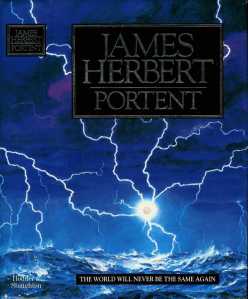
PORTENT
Now for the bad news. I’m fairly certain that Portent is Herbert’s worst book, which is sad because actually it contains some of his best writing. His creation of believable characters worldwide for the set pieces are finely realized, and some of the people in these passages are fleshed-out figures in detailed worlds, treated with the sympathy Herbert extended to nearly every person he wrote about – though some of the treatment of brown people is a little wince-making by its earnestness – but unlike the set pieces in the Rats trilogy, The Dark, The Survivor, etc, these all end with a dud. A light appears and the person dies. Every time. No development, no variation. These characters are, without exception, lovingly created in order to disappear when a light turns on.
Then there are the dream sequences of the twins. Again, these are surprisingly magical passages, unlike anything Herbert had written before, that conjure up impossible, rich dream landscapes. The mood, in these brief chapters, is reminiscent of the adult fantasies of George MacDonald (Phantastes, Lilith) and the tradition of which they are part, but Herbert simply goes there twice or thrice and then ignores them. Again, Portent gives a feeling of wasted talent: skill, effort, and beauty, carelessly abandoned. That’s twice at least that Herbert drops the ball, in one book.
Another problem with this book can be illuminated by comparison to Domain, the finale of the Rats trilogy. Basically, Domain introduces a set of characters in a bunker, and once the reader is used to them and an action scene is in flow, suddenly a new character is shoehorned in awkwardly and given a name, but not given any memorable hook other than that he is black. It has the feel of the storyteller saying “Oh, I forgot to mention this, but there’s a black man in the room. Did I mention there’s a black man in the room? So anyway, where were we…” It makes you wonder why the character’s been chucked in as an afterthought if he wasn’t important enough for the full introduction all the other main players get.
This black man is competent, sensible, and reliable – and he barely says two words. Then, when the action moves to a post-apocalyptic wasteland, everyone falls into the clutches of a mutant rebel horde, led by a screaming, crazy, rebel black thug. Our friend the featureless black man ends up sacrificing himself attacking this villain, and Herbert mentions that part of Hero Black’s reason for leaping at Wild Black is out of fury that his race is being ‘let down’.
I dunno, that passage never rang quite true to my ear. Although I think Herbert meant well, there is the possibility that he only introduced redundant Hero Black to counteract the implications of exciting, villainous Wild Black. What I’m saying, and I hate saying it, is that Herbert is diligently (but imperfectly!) whitewashing an otherwise paranoid racist fantasy – the main clue being the sheer weakness of his usually powerful writing when describing the “good” black character, compared to the authorial relish in the scene with the “bad” one.
So what’s that got to do with Portent? Well, I find the villain in Portent the most troubling of Herbert’s occasional troublesome villains. Having a large black woman be a psychotic, sadistic killer is in some ways an unexpected choice, and if he did it better, I would applaud it. But this woman is a voodoo sorceress, allowing all kinds of offensive slagging-off of her religious stance in, and she is persistently described in terms that emphasize her race as different, as Other, as bad.
Now: it could be argued that this monstrous literary portrayal (as with several other evil females in his books, Herbert expresses none of his usual sympathy or understanding for this ogress), like the black rebel in Domain, is offset by all the kind, painstaking portrayals of non-whites in Portent. By going out of his way to give some good tunes to people of colour in this novel, it might appear the Herbert the writer is repeating the whitewashing trick of Domain. It’s even plausible, to stretch a point, that if Herbert was doing this, it was more for reasons of aesthetic balance than as a political posture.
But for me, it doesn’t work, politically or aesthetically. It doesn’t hang together. In the same way that, in Domain, a weakly “good” black man is no match for a delirious, richly imagined “bad” one, so, in Portent, the litany of careful (sometimes flawed) portraits of non-white races all ending in white light and silence does not emotionally balance the white racist’s nightmare, this hulking, monstrous “Black Mama”.
Plus, Portent has an inane description halfway through of someone perfectly sliced in half by falling glass. Not only is it hard to convey how gratuitous and risible this scene is, it is also the first – perhaps the only – time Herbert added such a moment of needless ultraviolence. Normally, the physical pain in his work, the sense of the unutterable horror of bodily trauma is exactly what lifts his work above mere shock value. His sex scenes are spiritual and his violence exists in a world of moral significance: but not this death. It means nothing and oversteps the mark into comedy gore. That’s four flaws, some fairly large, in the one book.
But all of these flaws I could forgive, if it weren’t for Portent‘s big structural hole, its deus ex machina, its central cop-out. The most important meeting in the story is skipped. All the revelations the protagonist accepts, all the power he gains, all the issues he resolves, come together in his explosive meeting with the mysterious old man, a shamanic father-figure who communicates in the form of dreams. Everything in the story leads to this confrontation, and the main character and his narrative arc are changed forever as a result of it. But Herbert skips the scene!
It’s the wrong choice. None of his other books have a hole that big; in fact, a quintessential thrill Herbert gives his fans in book after book is the moment of coming face to face with a bigger power, whether good or bad. In this book there is no juicy bigger power: we’re denied a meeting with the shaman, the “cosmos” is too vague and impersonal a concept, and for the rest, he tries to palm us off with “Black Mama”. It’s no surprise to me that in the jamesherbert.com poll already mentioned, Portent, as voted by Herbert fans, sank firmly to the bottom of the list. It’s lame for a James Herbert book, despite some amazing passages. I have not enjoyed dissecting it.
On the other hand, the book signing when I met him was at the release of Portent, so I had a first-edition hardback with his signature in, which I gave away like a callow young pup when I had a clear-out a few years later. So maybe my problem with Portent is just sour grapes…
I intend to write about more of his work, but this can do for now.





